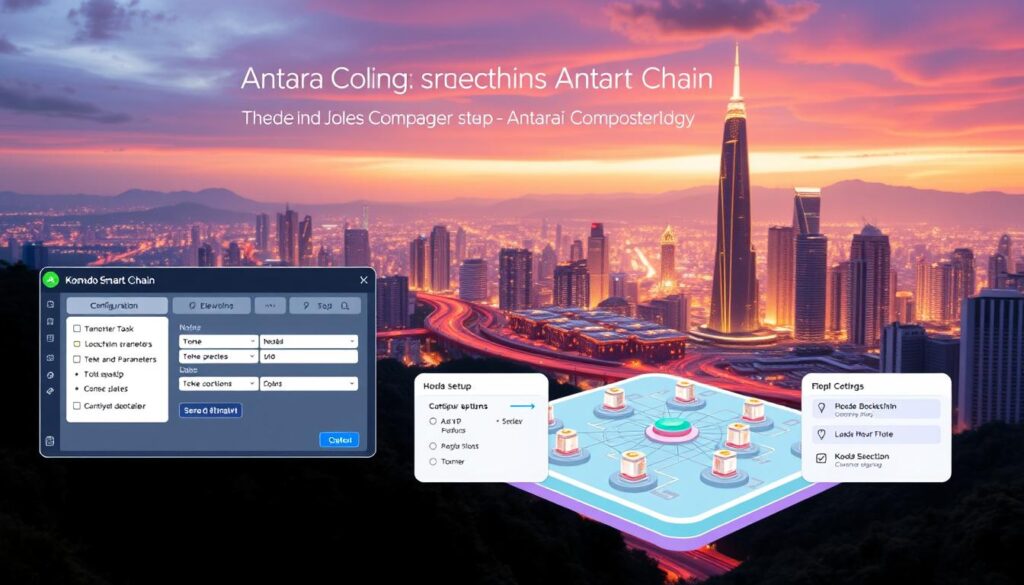Now Reading: Understanding Komodo Smart Chains and Their Uses
- 01
Understanding Komodo Smart Chains and Their Uses
Understanding Komodo Smart Chains and Their Uses

Modern blockchain systems often struggle with slow transactions, high costs, and rigid designs. A decentralized platform emerged to solve these challenges by letting developers build tailored networks. This adaptable ecosystem supports custom rules, security features, and cross-chain compatibility, making it ideal for businesses needing specialized solutions.
Originally launched in 2014, this technology evolved from early privacy-focused projects to incorporate advanced features like zero-knowledge proofs. These upgrades enable confidential transactions while maintaining public verification—a balance many enterprises require. Its multi-chain architecture allows projects to operate independently yet interact seamlessly, avoiding the bottlenecks of single-chain systems.
The framework emphasizes security through a unique consensus method that borrows Bitcoin’s hash power. This approach prevents network attacks while ensuring low energy use. Developers also benefit from open-source tools that simplify creating decentralized apps, exchanges, and asset management systems without sacrificing flexibility.
Key Takeaways
- Enables creation of customizable, secure blockchains for specific business needs
- Solves scalability issues through independent yet interconnected networks
- Integrates privacy features from earlier cryptocurrency innovations
- Uses Bitcoin-level security for attack-resistant operations
- Supports decentralized trading and cross-chain interactions
Exploring the Komodo Blockchain Ecosystem
Innovations in blockchain architecture are reshaping how enterprises approach decentralized systems. What began as a privacy-focused fork of Bitcoin Dark in 2014 has evolved into a versatile framework for commercial applications. Early integration of ZCash’s zk-SNARK technology laid the foundation for confidential transactions, allowing users to verify payments without exposing sensitive data.

Origins and Evolution from Bitcoin Dark to Modern Platforms
The platform’s roots in cryptographic research enabled rapid adoption of zero-knowledge proofs. By 2016, developers shifted focus toward solving enterprise challenges. This strategic pivot introduced multi-chain designs that let businesses run independent networks while sharing resources across the ecosystem.
Key Advantages: Interoperability, Privacy, and Scalability
Three core strengths define this ecosystem:
- Cross-chain compatibility: Assets move freely between networks using atomic swaps
- Data protection: Advanced encryption hides transaction details without compromising auditability
- Growth-ready design: Separate chains prevent congestion, cutting fees by up to 90% versus single-chain models
Open-source tools accelerate development, enabling teams to build custom consensus rules or governance models. Security remains paramount, with periodic audits and Bitcoin-level protection mechanisms ensuring network integrity.
Understanding komodo smart chains: Core Components and Benefits
Businesses seeking tailored blockchain solutions require systems that balance customization with robust protection. The technology’s architecture combines modular design principles with battle-tested security protocols, creating adaptable networks for diverse applications.
The Antara Framework’s Layered Design
This development toolkit operates through three interconnected layers. The base smart chain layer establishes independent blockchains with custom consensus rules and currencies. Pre-built modules then add features like payment automation or data verification through simple integration. Finally, cross-chain communication tools enable seamless interaction between separate networks.
Security Through Bitcoin-Powered Consensus
The platform’s delayed proof work (dPoW) mechanism provides unparalleled protection. Every ten minutes, network snapshots get permanently recorded on Bitcoin’s blockchain. This notarization process anchors operations to Bitcoin’s hash power, making attacks economically impractical.
Key advantages of this approach include:
- 51% attack prevention through Bitcoin’s established mining infrastructure
- Reduced energy consumption compared to traditional proof work systems
- Automatic recovery from potential chain reorganizations
Developers gain flexibility to design specialized networks while maintaining enterprise-grade security. The combination of modular tools and Bitcoin-backed verification addresses critical challenges in decentralized system design.
Empowering Developers with Multi-Chain Architecture
Building decentralized applications requires infrastructure that adapts to diverse technical demands. The multi-chain approach gives teams granular control over network operations through 23 adjustable settings during blockchain creation. This eliminates compromises between functionality and efficiency across industries like gaming and financial services.

Customizable Consensus Mechanisms and Unique Chain Parameters
Developers configure core blockchain characteristics through 18+ parameters. These include block intervals (0.5 seconds to 10 minutes), reward structures, and privacy levels. Unlike rigid platforms, this system supports alternative validation methods beyond Proof of Work, with future Proof of Stake integration via command-line tools.
Transaction economics remain chain-specific—fees use each network’s native currency instead of external tokens. This independence prevents gas fee fluctuations while enabling projects like Algorand to optimize for specific use cases through tailored rulesets.
Key customization features enable:
- Precise control over coin supply distribution
- Adjustable data encryption levels for transactions
- Network-specific governance models
Enterprises leverage these tools to create specialized networks for remittance processing or supply chain tracking. The architecture’s flexibility ensures seamless scaling as operational needs evolve, maintaining performance without protocol overhauls.
Launching Your Own Smart Chain with Antara Composer
Creating a customized blockchain network no longer requires extensive coding expertise. The Antara Composer platform simplifies this process through an intuitive dashboard, enabling developers to launch tailored networks in under an hour. Users start by visiting composer.kmd.io, where they can initiate their project after completing a straightforward registration.

Step-by-Step Registration and Dashboard Navigation
Begin by creating a new account with a verified email and strong password. Once logged in, the dashboard guides users through naming their chain and setting a unique ticker symbol. Critical details like wallet addresses and public keys must be entered accurately to ensure proper network functionality. Developers can upload brand logos and descriptions to personalize their blockchain’s identity.
Setting Up Blockchain Specifications and Privacy Options
Configure core parameters like coin supply distribution and block intervals to match project goals. The platform offers flexibility in privacy settings—choose between fully transparent transactions or hybrid models supporting confidential transfers. Advanced users can integrate modules for rewards programs or micropayments through simple toggle switches.
Final deployment requires selecting a consensus model and processing activation fees. Payments via cryptocurrency or PayPal trigger immediate chain activation, letting teams focus on building rather than infrastructure setup.
Enhancing Security and Scalability with Advanced Consensus Mechanisms
Blockchain systems face constant pressure to balance ironclad security with rapid growth capabilities. Advanced protocols address these dual demands through innovative verification methods and cross-network coordination.
Integrating Delayed Proof of Work for Robust Network Protection
The delayed proof of work (dPoW) system anchors security to Bitcoin’s blockchain through periodic notarization. Every ten minutes, 64 specialized nodes record network snapshots onto Bitcoin’s ledger. This creates an immutable backup that rejects unauthorized chain modifications.
Key protections include:
- Automatic rejection of blocks lacking Bitcoin-verified timestamps
- Energy-efficient validation using Bitcoin’s existing hash power
- Real-time detection of chain reorganization attempts
Leveraging Atomic Swaps for Seamless, Secure Transactions
Atomic swap technology enables direct cryptocurrency exchanges between users’ wallets. This peer-to-peer method eliminates third-party risks while maintaining full asset control. Transactions execute only when both parties meet predefined conditions.
Platforms like AtomicDEX enhance this process through:
- Decentralized order matching without custody requirements
- Cross-chain compatibility for 95% of digital assets
- Instant settlement finality across independent networks
The combination of dPoW security and atomic swaps creates a scalable ecosystem. Multiple chains process transactions simultaneously, achieving throughput levels unattainable in single-chain architectures.
Customizing Your Blockchain Experience
Tailored blockchain solutions empower organizations to overcome industry-specific challenges through precise adjustments. The Antara framework provides a modular toolkit for building specialized networks that align with unique operational needs. Developers gain granular control over 18+ configurable settings, from transaction privacy to economic models.
Selecting Modular Solutions and Tailoring Features
Teams assemble networks like digital Legos using pre-built components. Privacy settings let projects choose between fully transparent ledgers or shielded transactions with selective visibility. Adjustable block intervals (0.5 seconds to 10 minutes) enable trade-offs between speed and security. For initial coin distribution, creators define pre-mined supply percentages to support fundraising or loyalty programs.
Fine-Tuning Parameters to Fit Specific Use Cases
Consensus rules adapt to regulatory demands through configurable validation mechanisms. Gaming platforms might prioritize fast confirmations, while financial services require strict compliance checks. The system supports C/C++ programming for creating Turing-complete smart contracts capable of handling complex logic.
Economic parameters maintain network sustainability. Developers set block rewards to incentivize participation without causing inflation. Those looking to create specialized networks can combine modules for supply chain tracking or decentralized identity management. This flexibility ensures each solution evolves alongside business requirements.
Integrating Advanced Tools and Cross-Chain Capabilities
Digital asset trading enters a new era with tools that bypass traditional exchange limitations. AtomicDEX redefines peer-to-peer exchanges by supporting direct swaps across 99% of existing coins and tokens. This interoperability breaks down barriers between blockchain networks, enabling frictionless value transfers without intermediaries.
Atomic Swaps Meet Real-World Demands
The platform’s fee structure rewards active participants—market makers pay zero costs, while takers incur just 0.15% per transaction. Unlike centralized exchanges, users retain full asset control through wallet-to-wallet swaps. Instant settlements eliminate waiting periods for deposits or withdrawals, accelerating trade execution.
Cross-chain capabilities shine in practical examples like Bitcoin-to-ERC-20 transfers. Over 200,000 successful atomic swaps demonstrate the technology’s reliability. Smart contract integration through platforms like Komodo’s framework enables automated multi-chain operations, from escrow services to conditional payments.
Key advantages include:
- Unrestricted trading pairs across 50+ blockchain networks
- Enterprise-grade throughput exceeding 20,000 transactions/second
- Direct wallet swaps preventing third-party custody risks
FAQ
How do customizable consensus mechanisms improve blockchain flexibility?
Customizable consensus mechanisms allow developers to choose protocols like Proof of Work or Proof of Stake based on their project’s needs. This flexibility supports tailored security, speed, and energy efficiency, enabling networks to prioritize specific goals like transaction throughput or decentralization.
What role does delayed Proof of Work play in network security?
Delayed Proof of Work (dPoW) adds an extra layer of protection by periodically backing up a chain’s data to a more secure blockchain, like Bitcoin. This process prevents tampering and ensures transaction integrity, even if the primary network faces attacks.
Can users adjust transaction privacy levels within these ecosystems?
Yes. Privacy options like zero-knowledge proofs or selective transparency can be integrated during setup. This lets projects balance auditability with confidentiality, catering to industries like finance or healthcare that require strict data control.
How does multi-chain architecture enhance interoperability?
Multi-chain systems enable independent blockchains to communicate and share data through protocols like Atomic Swaps. This eliminates reliance on centralized exchanges, allowing assets to move seamlessly between chains while maintaining security.
What tools simplify launching a purpose-built blockchain?
Platforms like Antara Composer offer intuitive dashboards for configuring parameters such as block rewards, consensus rules, and privacy features. This reduces development time and technical barriers, letting teams focus on unique use cases.
Why are atomic swaps considered a breakthrough for decentralized trading?
Atomic swaps enable direct peer-to-peer token exchanges across different chains without intermediaries. This reduces costs, eliminates counterparty risk, and enhances liquidity by connecting fragmented markets.
How do modular solutions support scalable blockchain applications?
Modular frameworks let developers add or remove features like smart contracts or governance models as needed. This adaptability ensures networks can evolve with user demands, avoiding unnecessary bloat or complexity.
What advantages do tailored block rewards offer for network incentives?
Adjustable block rewards let projects control coin distribution rates, inflation, and miner/node incentives. This customization ensures long-term sustainability by aligning economic models with community or operational goals.














